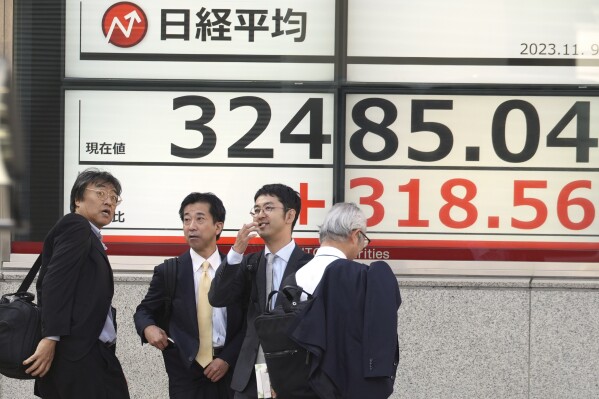
Asian shares were mostly higher Tuesday ahead of potentially market-moving developments, including a U.S.-China summit and data releases from the U.S., Japan and China.
Japan’s benchmark Nikkei 225 gained 0.5% to 32,757.44. Australia’s S&P/ASX 200 advanced 0.6% to 6,992.10. South Korea’s Kospi added 1.1% to 2,429.21. Hong Kong’s Hang Seng dropped 0.4% to 17,359.13 while the Shanghai Composite edged less than 0.1% higher, to 3,047.13.
“Asian stocks gained ground as investors awaited U.S. inflation figures, hoping to confirm that interest rates have peaked. Meanwhile, positive geopolitical sentiments filled the backdrop as investors looked forward to anticipated talks between the U.S. and China,” Stephen Innes, managing partner at SPI Asset Management, said in a written commentary.
On Wednesday, Chinese leader Xi Jinping is set to meet with President Joe Biden on the sidelines of a Pacific Rim summit in California. It will be the first face-to-face encounter in a year between the leaders of the world’s two biggest economies.
The profit reporting season for the summer is winding down, and most companies have again topped analysts’ expectations.
Later this week, Target, TJX and Walmart will report their results, and more attention may also be on what they say about upcoming trends than about the summer.
The economy has remained strong, even though the Federal Reserve has hiked its main interest rate to its highest level since 2001 in hopes of stamping out high inflation. But worries remain about whether it can stay solid as the full effects of rate hikes make their way through the system.
That’s why so much attention will be on Tuesday’s inflation report. The hope is that inflation will continue to cool from its peak in the summer of 2022, when it topped 9%, and convince the Federal Reserve that no more hikes to rates are necessary. That could speed up the timeline for potential cuts to interest rates.
Economists expect the report to show that consumers paid prices that were 3.3% higher in October than a year earlier, down from September’s inflation rate of 3.7%.
With inflation generally cooling, Federal Reserve Chair Jerome Powell recently suggested a recent rise in longer-term Treasury yields might act as a substitute for further rate hikes. But Powell said last week the Fed would not hesitate to hike rates again if needed.
In the bond market, the yield on the 10-year Treasury was at 4.63%, level with where it was late Friday. It’s come down over the last month on hopes the Fed may be done with its rate hikes, but is still well above where it’s been for years.
High rates and yields weigh on all kinds of investments, and they tend to hit technology and other high-growth companies particularly hard. Some Big Tech stocks were among the heaviest weights on the S&P 500, including a 0.9% dip for Apple and 0.8% slip for Microsoft.
The credit-rating agency Moody’s said late Friday that it could eventually downgrade the top-tier “AAA” rating it has for U.S. government debt given the cost of rising interest rates and political polarization in Congress, where a deadline looms that could result in a U.S. government shutdown.
General worries about big deficits and the inability of the two parties to work together have helped push Treasury yields higher.
In other trading, benchmark U.S. crude oil added 16 cents to $78.42 a barrel in electronic trading on the New York Mercantile Exchange. It gained $1.09 on Monday. Brent crude, the international standard, added 17 cents to $82.69 a barrel.
In currency trading, the U.S. dollar was unchanged at 151.72 Japanese yen. The euro slipped to $1.0699 from $1.0701.
___
AP Business Writer Stan Choe contributed.







